Exploring Rocks with Crystal-Like Features
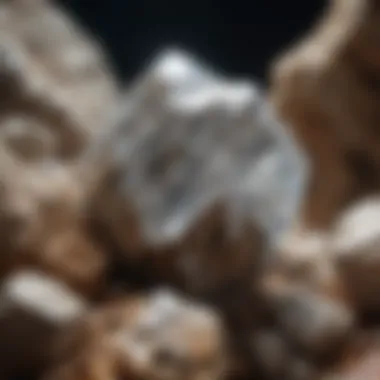
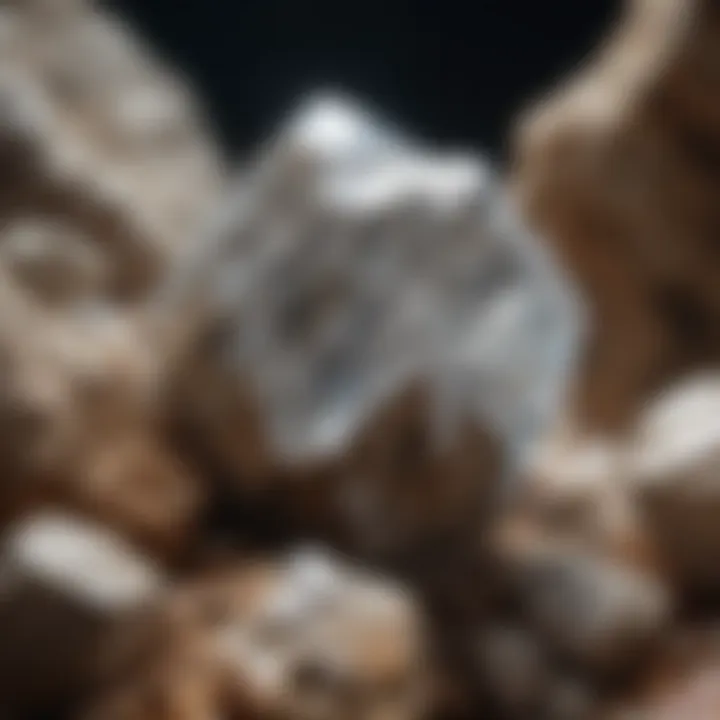
Intro
The natural world fascinates us in myriad ways, with rocks that bear a striking resemblance to crystals being among the most captivating. These formations, born from intricate geological processes, often lead to confusion for those unacquainted with the subtle differences between true crystals and their rock counterparts. Collectors, hobbyists, and nature enthusiasts can find immense beauty and value in these rocks, adding a unique dimension to their collections.
Understanding how these formations come to be reveals much about the Earth’s history and processes. This guide aims to explore the enchanting realm of rocks that mimic crystal qualities, diving into their formation, identification, and significance. A thorough grasp of these aspects not only enhances appreciation but also aids enthusiasts in making informed additions to their collections.
History and Origins
Overview of Collectibles, Rocks, and Fossils
Humans have been drawn to collectible objects from time immemorial. From the ancient cavemen who recognized the beauty of stones, to the modern rockhounds digging for treasures, collecting rocks has always been in our nature. Not all rocks shine like diamonds, but certain ones can trick the eye, resembling crystals that spark curiosity in collectors.
Many rocks that resemble crystals are formed through metamorphic processes or crystallization from magma or sedimentary materials. Understanding where these collectible items come from deepens our connection to them, transforming mere stones into pieces of history.
Historical Significance and Cultural Impact
Throughout history, various cultures have attached significance to these fascinating rocks. For instance, in ancient Egypt, lapis lazuli was as precious as gold. Cultures viewed such stones as not just decorative but also as vessels of spiritual power. Similarly, in ancient Greek society, certain stones were believed to protect the bearer and attract fortune.
The allure continues today, with many enthusiasts searching for these crystal-esque rocks to channel energies or simply to enjoy their beauty. Not only are these rocks cherished for aesthetic value, but they also reflect cultural narratives and beliefs spanning centuries.
"The rocks we collect tell stories deeper than their mere existence. They are links to our past, carriers of cultural heritage, and guides to understanding the planet we call home."
Identification and Classification
Guide to Identifying Rocks and Fossils
When faced with a new rock, identifying whether it resembles a crystal or is a true crystal becomes essential. While crystals exhibit a structured arrangement of atoms which reflects light beautifully, some rocks display similar features without exhibiting true crystalline structure. Here are some pointers to assist in identification:
- Look for Clarity: True crystals are often clear or translucent, while some rocks might appear cloudy or opaque.
- Examine the Structure: True crystals have defined geometric forms, whereas rocks may show irregular shapes.
- Test for Hardness: Use the Mohs hardness scale to check hardness; pure quartz is harder than many similar-looking rocks.
- Consider the Location: Certain regions are known for specific types, making field identification more plausible.
Common Types and Variations
Several types of rocks mimic crystal formations:
- Agate: Often banded and can appear as small crystal-like nodules.
- Chalcedony: A microcrystalline form of quartz that can resemble crystals in its rounded nodules.
- Calcite: Can form in a variety of shapes, often mimicking crystal structures with bubbles or inclusions.
- Fluorite: Known for its vibrant colors and resembling cubic crystals, but might exist in massive forms.
These rocks not only mesmerize with their appearance, but they also serve various uses in art, decoration, and as spiritual tools. Understanding these nuances can greatly enhance the joy of collecting.
This exploration of rocks that resemble crystals is just the beginning. Onward, we will dive deeper into their properties, significance, and how they can enhance any collection.
Intro to Rocks and Crystals
Exploring the intricate world of rocks that bear a striking resemblance to crystals reveals not just their visual allure but also their significance in various contexts. In geology and mineralogy, understanding rocks and crystals provides a framework for appreciating Earth’s diverse formations. For collectors and enthusiasts, the journey into this topic can be particularly rewarding, offering insights into how these specimens are formed and why they matter.
Defining Rocks and Crystals
Rocks and crystals hold different positions in the realm of geology, yet they intersect in fascinating ways. By definition, a rock is a natural solid substance composed of one or more minerals, mineraloids, or organic materials. On the other hand, crystals are solid materials whose constituents—atoms, molecules, or ions—are arranged in an orderly repeating pattern. In essence, all crystals are minerals, but not all minerals manifest in a crystalline form. This distinction, though subtle, can often baffle newcomers but is crucial for identifying the specimens you might find in nature.
A rock that looks like a crystal might be a sedimentary rock containing crystal fragments, or it could be a metamorphic rock reshaped under pressure and temperature. The beauty often lies in the overlap of these categories, revealing a spectrum of forms and textures that are incredibly engaging to study.
The Importance of Crystal Structures
The structure of crystals is foundational to their characteristics and behaviors. Each type of crystal forms based on specific arrangements of atoms. These arrangements not only dictate the crystal’s appearance but also its physical properties—hardness, luster, and cleavage are all influenced by the internal structure. For instance, quartz crystals exhibit a hexagonal shape, while calcite takes on a rhombohedral form. The different shapes arise from their unique internal orientations of atoms, which is an essential concept in mineralogy.
Understanding crystal structures also leads to practical applications. From industrial uses of quartz in electronics to the aesthetic charm of amethyst in jewelry, the properties of crystals have real-world significance that improvise both the economic and cultural aspects of society. Moreover, appreciating the architectural nature of these structures enhances a collector's ability to identify and differentiate between common types and rarities in their collections.
"By digging deeper into the definitions and structures, collectors can transform their hobby into a nuanced understanding of geosciences."
In summary, the interplay between rocks and crystals, and a grasp of their definitions and structural importance, creates a rich backdrop for further exploration. These initial concepts lay the groundwork for discussing formation processes, characteristics, and applications, broadening our awareness of the natural world surrounding us.
Geological Processes Behind Crystal-like Rocks
Understanding the geological processes that create rocks resembling crystals is crucial for appreciating their beauty and unique qualities. By unraveling the formation of these stones, we can gain insights into the natural environments they originate from and the historical contexts that shaped them. These processes not only highlight the intricate relationships between minerals but also invite enthusiasts to deepen their knowledge about the earth’s complex systems.
Formation Processes Explained
Igneous Processes
Igneous processes are among the primary ways rocks form, arising from the cooling and solidification of molten rock or magma. When magma erupts from a volcano and cools quickly, it can create unique crystal-like formations. One key characteristic of igneous processes is the rate of cooling, which greatly influences crystal size and clarity.
The rapid cooling of volcanic lava often leads to finer, glassy textures, while slower cooling within the earth's crust may produce larger, well-defined crystals. The quartz that forms from igneous processes can also be striking and sought after due to its wide array of colors and transparency.
One drawback, though, is that igneous rocks can be harder to find compared to sedimentary ones. Thus, collectors might have to do a bit of legwork to discover these crystalline forms hidden in volcanic terrains.
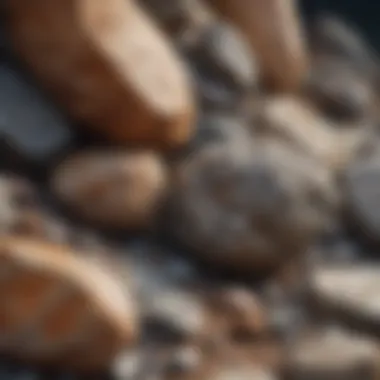

Metamorphic Transformations
Metamorphic transformations occur when existing rocks undergo intense heat and pressure, causing them to change physically and chemically. This process can create eye-catching features that make these rocks appear crystalline. The key aspect here is that the original rock, be it igneous, sedimentary, or even another metamorphic rock, has a significant impact on the final product.
The beauty of metamorphic rocks lies in their varied textures and layered appearances. For instance, schist and gneiss can exhibit beautiful foliation patterns, reminiscent of crystals. However, while these rocks typically possess stunning aesthetics, they can sometimes be challenging to identify accurately due to their complex history.
Sedimentary Deposition
Sedimentary deposition is another method through which rocks that resemble crystals can form. This happens when particles accumulate over time, often in bodies of water like lakes and seas. The key characteristic of sedimentary processes is their ability to capture organic materials along with minerals.
The resulting rock, such as calcite or gypsum, can sometimes exhibit crystal-like structures, especially when they form in specific environmental conditions. The advantage of these rocks is that they are generally more accessible for collectors, as they’re frequently found in riverbeds and sedimentary basins. However, they may not always have the same level of clarity or durable nature as those formed from igneous processes.
Mineralogy Basics
Diving deeper into mineralogy provides a better understanding of how various rocks resemble crystals. It’s essential to look at the fundamental elements and compounds constituting these amazing formations.
Elements and Compounds
Elements and compounds are crucial in determining the characteristics of crystal-like rocks. Each mineral has a specific chemical formula that dictates its properties, including color, hardness, and reactivity. For example, quartz is primarily made up of silicon dioxide, while calcite consists of calcium carbonate. Understanding these compositions is beneficial for enthusiasts in identifying and classifying rocks. Furthermore, some minerals can react differently in various environments, posing both opportunities and challenges for collectors.
Mineral Categories
Mineral categories help to streamline the understanding of distinct types of crystals within rocks. Different categories - such as silicates, carbonates, and oxides - can provide valuable insights about a rock’s formation and potential uses. Each category carries unique physical and chemical properties that may influence their desirability among collectors.
The complexity of mineral categorization allows enthusiasts to appreciate the unique features of their rocks, broadening the scope of exploration.
Understanding these geological processes and mineralogical principles ultimately enhances one’s ability to identify, appreciate, and collect rocks that bear striking resemblance to crystals.
Characteristics of Rocks That Resemble Crystals
Understanding the characteristics of rocks that resemble crystals is crucial for both enthusiasts and collectors. This segment sheds light on both physical and chemical properties that define these formations, enhancing appreciation and knowledge in this fascinating area of geology. By dissecting these qualities, readers can identify, collect, and discuss these beautiful examples of nature's artistry with greater confidence and skill.
Physical Properties
Color and Clarity
When it comes to rocks that mimic crystals, color and clarity are often the first traits that catch the eye. These properties not only contribute to their aesthetic appeal but also indicate the mineralogical composition. For instance, a vibrant purple amethyst stands out amongst its more muted companions due to its rich color saturation.
Key characteristics such as
- vivid hues
- transparency levels
allow collectors to distinguish a genuine specimen from a mere impostor. Clarity impacts how light interacts with the stone, providing hints about its purity and the presence of inclusions.
One unique aspect of color in these rocks is that it can change based on lighting, so it’s wise to evaluate specimens in various settings. However, a downside is that certain exciting colors can mislead a collector about the type or value of the rock. Different lighting conditions can reveal hidden flaws in clarity too, making this a delicate balance in appreciation and evaluation.
Hardness and Luster
Hardness, an indicator of a rock's resistance to scratching, plays a pivotal role in identifying rock types. The Mohs scale, which ranks materials based on scratch resistance, can help enthusiasts categorically identify their specimens. For example, quartz has a hardness of 7, allowing it to withstand incidental wear better than softer minerals.
Luster encompasses how light reflects off a surface, classified into categories such as
- glassy
- pearly
- dull
This reflects the rock's mineral composition, greatly influencing its visual impact. Hardness contributes to the practicality of a collectible; a higher hardness typically suggests durability, while a desirable luster can enhance display appeal.
That said, heavier hardness might deter some from working too closely with the material. Some rocks that possess brilliant luster might be easily scratched or damaged, meaning those stunning surfaces could be at risk if not handled properly.
Transparency and Translucency
Transparency and translucency measure how much light can pass through a rock. Transparent specimens, such as certain variations of quartz, can often be appreciated for their clarity, allowing light to dance through them. In contrast, translucent materials might provide a soft glow, giving a different yet equally enticing aesthetic.
The key to understanding these terms is recognizing their influence on the rock's value and desirability. Transparent rocks may fetch higher prices as they often exhibit fewer internal flaws compared to their translucent or opaque counterparts.
- Transparent: Can see through completely
- Translucent: Sufficient light passes, but details cannot be made out
- Opaque: No light passes through
However, while transparency can elevate the aesthetic of a piece, an overly opaque specimen might hold unique charm and character, marking its place as a valuable find.
Chemical Properties
Composition and Structure
The composition and internal structure of rocks are paramount in understanding their unique characteristics. These attributes define how the rock was formed and how it might react to external factors. Layers of minerals arranged in specific patterns can yield vibrant colors and interesting textures.
For instance, calcite and aragonite both share the same chemical formula (CaCO₃) but have different structures, resulting in diverse physical properties. A beneficial aspect is the identification based on composition can lead collectors to rare finds or more common varieties, adding layers to one’s collection.
On the downside, a complex internal structure may lead to confusion during identification. Misjudging the chemical makeup can result in mistakenly categorizing a rock, which can be quite the pickle during trading or valuation discussions.
Reactivity with Acids


The final chemical property to consider is the rock's reactivity with acids, a notable element especially for carbonates like calcite. When acid is applied, effervescence occurs, causing bubbles to form and providing a clear sign of the rock's composition. This simple test can confirm suspicions and elevate a collector's confidence in their findings.
This property is essential for distinguishing between sedimentary minerals and igneous rocks, closing gaps in understanding. But this comes with a caution—testing should be done carefully as not all rocks are stable when exposed to acids, leading to potential erosion or damage.
Some rocks may put on a show when acidic substances are applied, revealing colors or patterns formerly hidden. Yet, misuse in testing could ruin a specimen, causing irreversible harm, so precision is vital.
"By delving into the physical and chemical properties, hobbyists can truly appreciate the artistry that these rocks portray, enriching their collections with informed choices."
Through these characteristics, one can unlock the facets that make rocks resembling crystals not just items of beauty but captivating pieces of Earth's geological history.
Common Examples of Rocks That Look Like Crystals
When exploring the realm of rocks that bear a striking resemblance to crystals, it's crucial to highlight specific examples that stand out due to their unique visual properties and geological significance. This section delves into the common groups of these fascinating rocks, helping collectors and enthusiasts appreciate their distinctive features and potential applications. Knowing these examples not only enhances understanding but also aids in the identification and value assessment of these materials.
Quartz Variants
Rose Quartz
Rose Quartz is often celebrated for its gentle pink hue. This soft color comes from the presence of trace minerals like titanium, iron, or manganese, which can permeate the crystalline structure during formation. The key characteristic that makes Rose Quartz a favored choice among collectors is its widespread availability and relative affordability. Its stunning aesthetic appeal makes it a popular choice for jewelry, home decor, and even in healing practices, as it's often associated with love and emotional healing.
Despite its beauty, Rose Quartz can have disadvantages. It is moderately hard, registering about a 7 on the Mohs scale, which means it can chip or scratch with enough force. Thus, careful handling is recommended when used in more fragile settings.
Amethyst
Amethyst stands out for its deep purple coloration, which results from iron impurities within the quartz structure that undergo cyclization during natural radiation. As a variant of quartz, it maintains similar toughness, which contributes to its popularity. Amethyst's visual characteristics encompass a rich range of purples, sometimes featuring lighter patches or deeper, more vibrant shades.
This mineral is often sought after for its use in jewelry and decorative objects. Its strong connection to spirituality, thought to enhance calm and clarity, makes it a favored stone among many. One downside might be its cost; fine-quality Amethyst can be pricier than other quartz variants, impacting accessibility for novice collectors.
Citrine
Citrine, recognized for its warm, yellow-orange hues, is another member of the quartz family that captivates collectors. Its color derives from iron within the crystal lattice, and high-quality specimens can be as striking as fine jewelry. This stone is frequently considered a positive energy stone, purportedly bringing wealth and prosperity to its owners, thus amplifying its appeal in both metaphysical and aesthetic contexts.
However, Citrine can be sometimes confused with other yellow stones, such as Yellow Topaz, due to similarities in color. It typically has a lower degree of hardness compared to other quartz variants, making it potentially less durable for everyday wear unless properly protected.
Calcite and Aragonite
Calcite and Aragonite, while often mistaken for one another due to their similar appearance, actually have distinct characteristics. Calcite, composed primarily of calcium carbonate, exhibits a variety of crystalline forms and is widely known for its optical properties, such as double refraction. Aragonite, on the other hand, is another polymorph of calcium carbonate, formed under different conditions, generally at higher pressures. This difference in formation affects their structures and uses.
Other Notable Minerals
Fluorite
Fluorite is notable for its vibrant clarity and color variety, ranging from greens and purples to stark shades of yellow. This mineral has a unique feature: it can fluoresce under ultraviolet light, which makes it highly desirable for collectors and fabulous for decorative purposes. Its cubic crystal form is distinctive, offering a geometric quality that appeals to the aesthetic instincts of many.
The downside is that Fluorite has a lower hardness of about 4 on the Mohs scale, meaning it requires extra care during handling and storage to avoid scratches or damage.
Pyrite
Often referred to as "fool's gold" due to its deceptive metallic luster and pale brass color, Pyrite has been historically significant in mining. Its distinctive cubic crystals can form masses that are particularly attractive to collectors. Beyond looks, Pyrite is rich in iron, which adds economic value in certain industries.
However, collectors should note that due to its composition, Pyrite can oxidize and become brittle when exposed to moisture over time, necessitating proper care and storage.
Selenite
Selenite is recognized for its ethereal glow and the sheer transparency it offers. Stone enthusiasts appreciate its softness and remarkable ability to form long, slender crystals. It's often used in spiritual and metaphysical practices, famous for promoting clarity and serenity. The downside of Selenite is its softness; ranking at about 2 on the Mohs scale, it can easily be scratched and damaged, thus requiring gentle handling.
In summary, understanding these common examples of rocks that resemble crystals not only enhances appreciation for their beauty but also aids collectors in making informed choices based on their specific characteristics and potential applications.
Differentiating Between Rocks and True Crystals
Understanding the difference between rocks and true crystals is essential for anyone diving deep into the captivating world of mineralogy. While at first glance, some may seem similar, the underlying formation processes and structural attributes set them apart distinctly. This differentiation enhances one’s ability to appreciate the variety and allure of natural formations. In a collecting context, discerning between the two can determine the value of pieces in one’s collection, impacting decisions around purchase, categorization, and future trade.
Understanding Crystal Formation
True crystals form through specific processes that dictate their molecular arrangement. They exhibit repetitive geometric shapes, which allows them to grow uniformly in three dimensions. Key to crystal formation is the cooling and solidifying of various minerals from magma or solutions, leading to the intriguing shapes we see. For example, quartz crystallizes when silicon dioxide precipitates from hot vapors or cool liquids in the Earth�’s crust. Additionally, crystals are typically more homogeneous in composition when compared to rocks, which can consist of an amalgamation of many minerals.
Visual Identification Techniques
Differentiating rocks from crystals often relies on careful examination. Here are two of the crucial techniques:
Surface Characteristics
Surface characteristics provide a wealth of information about the identity of a specimen. For instance, crystals are often shiny and exhibit smooth reflections due to their well-defined outer structure. The key characteristic to look for is the mirror-like sheen of a crystal, indicating a uniform growth pattern, unlike many rocks that may have rough or uneven surfaces.
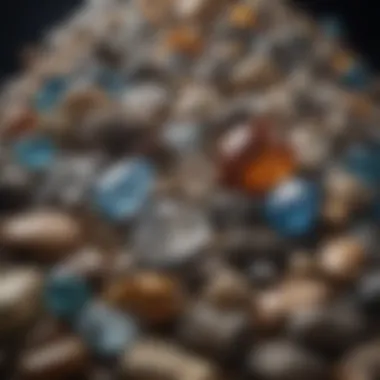
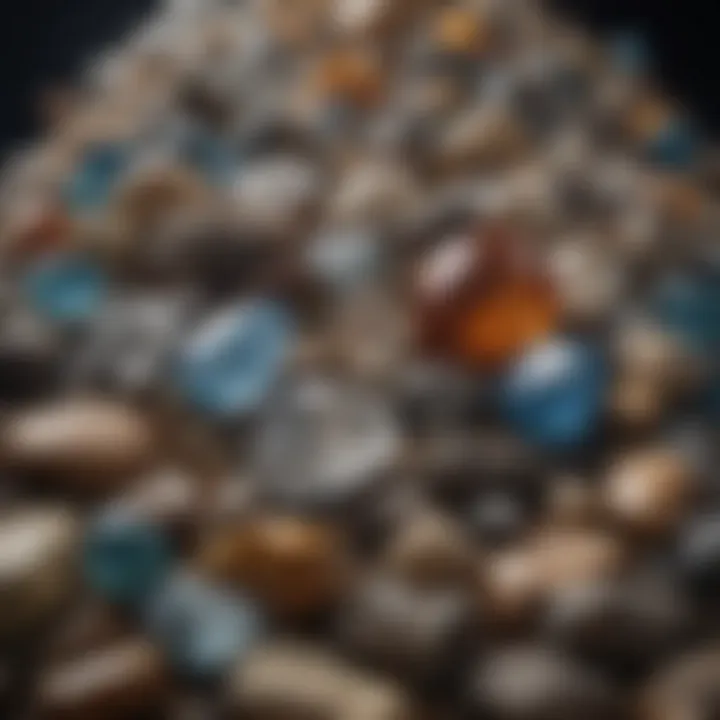
Additionally, a crystal’s surface may show well-formed facets, while rock surfaces can appear rugged and fragmented. This difference makes examining surface characteristics a popular choice when collecting. A primary advantage is that anyone can conduct these observations without specialized equipment, utilizing just the naked eye and perhaps some light. However, it’s important to note that wear from elements can obscure such features, making some rocks deceptively crystalline.
Internal Striations
Internal striations also play a vital role in identification. These are fine lines or grooves that can be observed within a crystal. A key characteristic of internal striations is their consistent alignment and spacing, which often reflects the crystal's growth history. This feature is particularly beneficial when examining quartz varieties, such as amethyst or citrine, as they can display unique striation patterns.
The unique feature of internal striations lies in their ability to indicate the specifics of a crystal's environment during formation. Knowing this can be an advantageous aspect for collectors. In contrast, rocks generally do not have such distinct, consistent internal patterns because they form from various minerals coming together without uniform growth. However, identifying these striations can be a challenge, as they may be subtle and require closer inspection with tools like magnifying glasses or even microscopes.
"By understanding the nuances of rock versus crystal, collectors can build collections that are not only aesthetically pleasing but also scientifically enriching."
Collecting Rocks That Look Like Crystals
Collecting rocks that imitate crystals represents a blend of science, beauty, and personal expression. Many enthusiasts embark on this journey, entranced not just by the aesthetic allure but also by the stories and histories embedded in each specimen. For those keen on expanding their knowledge or their collection, understanding the nuances of this hobby is essential. This section delves into how you can begin your collection, take care of your finds, and ensure they are showcased appropriately.
How to Start Your Collection
Starting a collection of rocks resembling crystals is akin to embarking on a grand adventure. Each piece tells its own story dictated by time and geological processes. Begin by identifying your interests—perhaps you are drawn to quartz variants or minerals like selenite or pyrite.
- Research: Equip yourself with knowledge about the types of rocks available. Books, online forums, and local rock shows are excellent resources.
- Field Guides: Invest in a field guide that’s specific to your area that includes images and descriptions of local crystal-like rocks. This can significantly aid in identifying specimens during your hunts.
- Join a Community: Connect with local rockhounds or online communities like Reddit’s r/mineralcollectors to share insights and experiences.
- Field Collecting: Venture into nature. Hiking trails, riverbanks, or geological formations can serve as ideal hunting grounds for crystal-like rocks. Always remember to ask for permission if you are collecting on private land.
- Purchasing: Sometimes, the easiest way to start is to purchase specimens. Local gem and mineral shows, as well as online retailers, can provide beautiful specimens to kick off your collection.
Proper Care and Maintenance
Once you’ve gathered a selection of rocks, proper maintenance will be key to preserving their beauty and integrity. Taking care of them means ensuring they remain in the best possible condition and can be enjoyed for years to come.
Cleaning Techniques
Cleaning techniques for your collection may vary depending on the type of rocks involved. A simple approach is often the most effective.
- Gentle Washing: Most rocks can be rinsed off with water. Use a soft brush to remove dirt without scratching the surface.
- Soaking in Mild Soap: A mixture of warm water and a mild detergent can be used for stubborn grime. Just make sure to dry them thoroughly afterward to prevent moisture damage.
- Avoid Harsh Chemicals: Many chemical cleaners can be too abrasive. Staying away from acidic cleaners is a safe rule of thumb.
Careful cleaning helps maintain the luster of your crystals, ensuring they capture light beautifully while avoiding unwanted blemishes. But do take caution; some rocks might have fragile structures. Gentle methods work best here.
Storage Solutions
How you store your collection can greatly impact its longevity. Proper storage protects your treasures from physical damage and environmental factors that could degrade their quality.
- Soft Cases or Pouches: Individual soft fabric pouches can prevent scratches between rocks. Consider using cotton bags or specialized mineral pouches.
- Display Cases: For more impressive specimens, consider using a glass display case. This not only protects but also showcases your collection effectively.
- Avoid Direct Sunlight: Store your rocks in a cool, dry spot, away from harsh sunlight which could fade their colors over time.
Utilizing proper storage ensures your collection not only remains safe but can also be beautifully displayed for friends and visitors to admire.
“Each rock in your collection is a chapter of the Earth’s story, waiting to be told.”
The Significance of Crystal-like Rocks in Society
Rocks that resemble crystals are not only intriguing for their aesthetic appeal, but they also hold considerable significance in different aspects of our lives. When we delve into the cultural and industrial relevance of these rock formations, we can grasp their unique positions in various societal contexts. From ancient times to present day, the allure of crystal-like rocks has permeated cultures and industries alike, reflecting both beauty and utility.
Cultural Importance
Culturally, crystal-like rocks have a rich history that goes beyond mere decoration. Many civilizations have revered these formations, believing them to possess mystical properties. For instance, in ancient Egypt, lapis lazuli was valued not just for its vivid color but also for its supposed protective qualities. It was often used in jewelry and adorned the tombs of the pharaohs to guard them in the afterlife.
Similarly, in various indigenous communities, stones like turquoise are not only seen as beautiful materials but also as symbols of harmony and healing. These rocks are often incorporated into rituals and art, serving both spiritual and expressive purposes.
Moreover, the healing crystal trend has surged in modern society, with individuals turning to rocks such as rose quartz and amethyst for their purported emotional benefits. This revival illustrates how crystal-like rocks continue to shape cultural narratives and personal beliefs.
Industrial Applications
Beyond their cultural significance, crystal-like rocks play vital roles in industrial applications as well. The varied mineral compositions present in these rocks can be harnessed in multiple ways, contributing significantly to different industries.
- Construction: Many crystalline rocks, such as granite, are extensively used in building and architecture due to their durability and aesthetic qualities.
- Electronics: Quartz crystals have become crucial in the electronic sector. They are used in oscillators and timekeeping devices, providing accurate frequency references essential for modern technology.
- Cosmetics: Some of these rocks are processed into powders for cosmetic applications, leveraging their natural mineral composition to enhance products.
- Therapeutics: Specific minerals found in crystal-like rocks are employed in a variety of health products, suggesting a bridge between ancient cultural practices and contemporary health trends.
The intersection of cultural experience and practical utility showcases a profound narrative about human relationship with crystal-like rocks. As we continue to explore and appreciate these breathtaking formations, we uncover not just their geological significance but also their enduring place in human achievements and societal values.
"The resonance of crystal-like formations transcends mere appearance; they are historical tokens and industrial beacons that mirror humanity's evolving journey."
In summary, stone collectors and enthusiasts can take solace in the profound legacy that rocks resembling crystals carry. The dual facets of culture and industry underline the multifaceted importance of these natural treasures, providing a well-rounded understanding of why they continue to captivate our attention.
Finale
The significance of rocks that resemble crystals extends beyond mere aesthetic appeal. They serve as tangible connections to Earth’s geological history and reveal the complex processes that shape our planet over eons. This article aims to illuminate the diverse forms and structures of these intriguing rocks, enhancing our understanding and appreciation of nature's artistry.
Reflecting on Earth's Natural Beauty
Every rock that mimics a crystal tells a story about the earth's past. From the rolling hills to the deepest caverns, these formations are not just naturally occurring but are also symbols of perseverance and time. They manifest in various forms, colors, and textures—each piece a testament to the intricate and often unpredictable journey of geology.
Moreover, the beauty found in these rocks serves as a reflection of nature’s creativity. Just as artists find inspiration in their surroundings, rock and fossil collectors can appreciate the delicate details within these formations. The lustrous sheen of polished quartz, the soft shades of rose quartz, or the intricate patterns in limestone echo nature's palette and craftsmanship.
"Every stone has a story hidden within its layers, waiting to be discovered by the curious mind."
In addition to their natural beauty, crystal-like rocks also bear witness to various cultural significances. Throughout history, many societies viewed these stones as objects of power, healing, or beauty. Their mystique often leads to a deep-seated reverence that resonates through art, literature, and tradition.
Understanding these rocks not only feeds a collector’s passion but also elevates our overall respect for the environment. Recognizing their beauty encourages conservation efforts and appreciation for geological diversity. Ultimately, as we reflect on Earth's natural beauty, we unlock a deeper understanding of our planet's past and its ongoing journey, all encapsulated within these fascinating crystal-like rocks.



